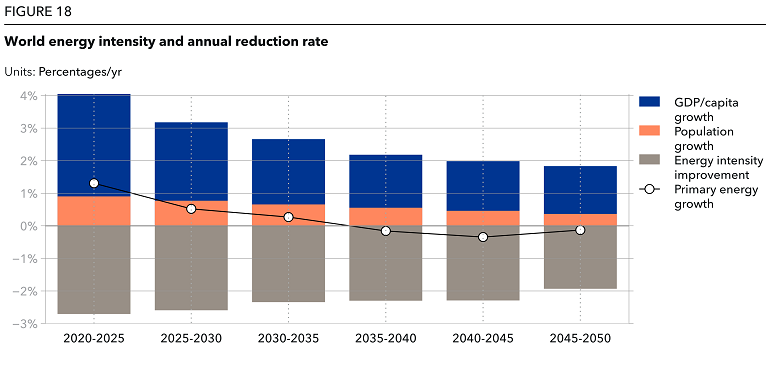High energy prices in 2022 have highlighted speed with which energy efficiency initiatives can significantly, and often permanently, ratchet down energy use and costs.
Removing inefficient and expensive energy practices is a defining feature of the energy transition over the next three decades and should be the top priority for individuals, companies, and governments focused on transitioning faster and on achieving energy security.
The figure below plots energy intensity, population growth, and GDP per capita growth as annual average values within five-year intervals between now and 2050. After 2035, the reduction in energy intensity is stronger than the combined growth of population and GDP per capita. Hence, growth in global primary energy supply turns negative and primary energy supply peaks in the mid-2030s.

Over our forecast period in which we foresee a doubling (107%) of global GDP and an 8% increase in primary energy consumption, energy intensity will be more than halved from 4.3 MJ/USD to 2.1 MJ/USD. In the 2040s, the intensity improvements taper off somewhat because, there will be fewer opportunities for further efficiency gains in power generation and energy end use.
Rapid electrification powered by renewables is the core driver of accelerating energy efficiency in the next three decades. The typical thermal efficiency for utility-scale electrical generators is some 30 to 40% for coal and oil-fired plants, and up to 60% for combined-cycle gas-fired plants. In comparison, solar PV and wind generation are 100% efficient, and conversion losses as a percentage of input energy in power generation reduce from 51% in 2019 to 19% in 2050.
Most end-use efficiencies are also linked to electrification, for example EVs, which are three to four times more efficient than ICEVs. We also take into account technology improvements resulting in better engine performance, hull hydrodynamics or insulation. We find that without expected efficiency gains in transport, buildings, and manufacturing, energy demand would be 65% higher than we forecast for 2050.
There is potential to accelerate efficiencies beyond our forecast, but that will require new mandates from governments, action on demand side flexibility, and co-operation within industries on new standards and recommended practices.